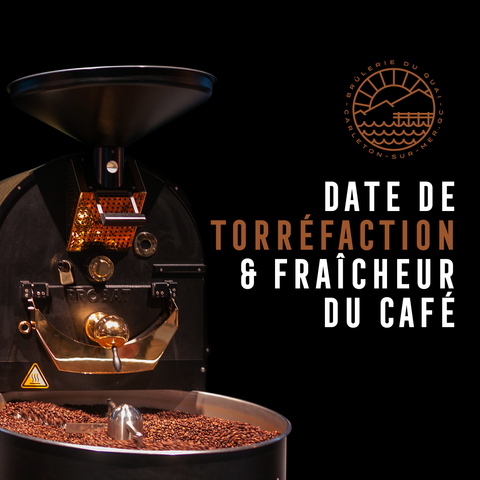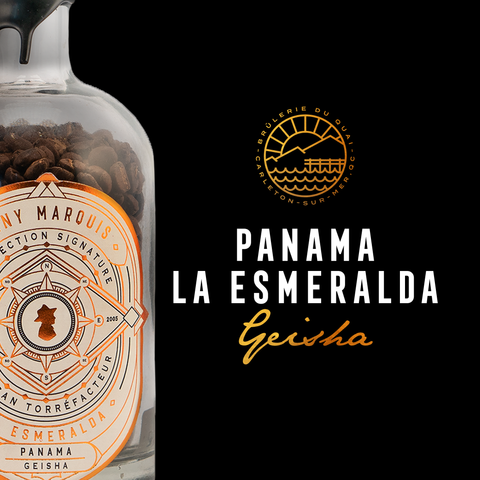
A few years ago, emerging third-wave roasters were looking to make their mark in the coffee world. They found takers among an insider clientele, but to reach the general public, a guerrilla war had to be waged to convince consumers to try their products. In the points put forward in their communication, the freshness of the roasting was pushed as an indicator of quality.
It was a brilliant strategy, because the big industrial roasters and the more old school roasters couldn't apply the same approach.
For a coffee company primarily focused on mass markets, adding roasting dates to bags is difficult; customers would end up with coffees dated 6-7 months ago and sometimes even more. The level of complexity of the production logistics and distribution of their coffee makes ''just in time'' production very complex for this type of market. This is why almost all the coffees on the shelves of supermarkets have been roasted several months before, but consumers, accustomed to this, do not ask too many questions.
So the new roasters, including Brûlerie du Quai, scored points on this subject and it was a major educational point for consumers.
They began to discover that a freshly roasted coffee is truly superior to one that took 6 months to reach the supermarket shelf. This is also one of the reasons why buying coffee online is now so popular and almost the norm for coffee lovers.
While micro-roasters have won on this point, the perception of coffee freshness for coffee drinkers newly introduced to the concept has suffered some distortion.
Some people have started to apply the definition of the freshness of bread to that of coffee. Fresh bread is good the same day and they have the impression that it's the same with coffee, which is not the case at all.
A coffee that is too cold is unpleasant, even for a great vintage.
There are also some preconceived ideas of the rules that are not entirely wrong, but do not represent the reality and complexity of coffee.
So, we will hear that a coffee intended for the filter will come out well after 4 days and that for an espresso, it is 7 to 9 days after roasting. It is also said that after this period the quality of the coffee begins to decline.
In reality, this is not exactly the case. It is unfortunately (or fortunately) more complex.
It all depends on the roasting level, type of bean, storage conditions, type of preparation, etc. There is an optimal window, but it varies from coffee shop to coffee shop.
I would tell you that one of the major elements for the development of the aromas of a coffee is its level of roasting. And this process, depending on its level of intensity and the development of the bean, will have a significant impact on the aging of the coffee.
Light roasting: 14 to 30 days (and more if adding food nitrogen type gas)
Medium to dark roast : 7 to 14 days
After resting, the coffee will have a clearer and more assertive profile, more balanced between its sweetness (sugar) and its acidity. The grain harmonizes and the result in the cup is even more recognizable, as if its personality were expressed perfectly.
Note that this applies to light roasted coffees intended for tasting, i.e. our grands crus;Signature collection , Select Reserve and certain Prestige .
So this is more about the ideal window of freshness.
For the conservation of coffee, I recommend reading this text:
We also recommend the use of airtight containers like these:
With integrated vaccum pump: Fellow Atmos vaccum
Or a simpler version: 200g amber glass container
If you want to go further, you can follow me in the rest of the text where I will discuss in more detail where I get my information on coffee conservation.
When a coffee bean is roasted, during cooking, gases are formed in the porous structure of the bean, mainly carbon dioxide (CO2). There will therefore be a release of gas, degassing, which will occur after roasting, mainly CO2, but also other gases created during cooking. This degassing will therefore take place slowly during storage, and quickly if the coffee is exposed to air. Degassing will also be greatly accelerated when the grain is ground.
It is CO2 which mainly contributes to the creation of crema for espresso, and which, in too large quantities, affects extraction and masks the flavor and clarity of the beverage. You may have already noticed that coffee that is too cold results in a coarse, very thick crema espresso with not a very interesting taste.
Moreover, I would like to take this opportunity to say that the presence of excessive crema is not a sign of a quality drink.
To go further into the science, I invite you to take a look at this research article:
Time-Resolved Gravimetric Method To Assess Degassing of Roasted Coffee
The article demonstrates a precise and quantifiable approach to the degassing process of roasted coffee.
This test was carried out by measuring the weight loss of a container filled with coffee. The tests were carried out with nine samples of the same coffee (El Salvador Arabica) roasted on a Probatino model roaster. They had three light roast samples, three medium roasts and three dark roasts, with varying roasting speeds (bean temperature and convection).
The roasting protocol was similar, but with the burner gas adjustment at 90% for fast batches, 60% for medium, and 40% for slow batches.
So, three levels of roasting, with three different curves, depending on a factor of speed, and therefore intensity of the roasting.
They also did the same thing with a robusta from Vietnam.
It's fascinating!
I will spare you the complete protocol, but it is well described in the article that I invite you to read. The approach is purely scientific and, even if the curves had not necessarily been optimized as is done for tasting, the results are directly applicable to our work.
We can conclude that the level of roasting, especially when it is darker, has more impact on the speed of gas release than other factors. We can also see in the results that lightly roasted coffee beans continued to outgas after 30 days. As for the impact of the pace of cooking, with different intensity adjustment, medium and darker roasts have a different rate of gas release depending on the intensity of cooking. So, the faster the cooking, the more the release will be increased.
On light roasts, speed had little impact on gas release.
We can therefore say that the degassing speed is directly linked to the difference in porosity between the coffee beans. The darker and faster a bean is roasted, the more porous its structure will be and will allow carbon dioxide to escape easily, taking with it precious volatile components which will no longer be found in the cup.
It is therefore a considerable technical challenge which amplifies the relationship between the roaster and the consumer. Coffee is a product that cannot be put into capsules if you want to take full advantage of it, regardless of the capsule and pod sellers and the large-scale coffee sellers. It is an extremely complex product and knowing its evolution after roasting requires even greater collaboration.
More than ever, modern consumption creates a marriage between the two actors in the purpose of coffee production, namely the roaster and the person who will prepare the cup of coffee. And this particular relationship must be experienced in accordance with the nature of the product worked and not according to what society pushes us to become.
As for my approach to offering the maximum quality to my customers, I will therefore allow myself to create a certain buffer between the sending of our coffees and the roasting so that you can enjoy them upon receipt. And if the roasting date is too close, I advise you to wait until the coffee is ready.
Respecting the product, thinking about all the journey, all the work required until the cup can only amplify the experience of tasting this wonderful beverage.
Danny Marquis
Some links and additional information:
The roasting process produces gases inside the bean due to several chemical reactions including:
Cengel, Y.A., & Boles, M.A. (2012). Thermodynamics An Engineering Approach . McGraw-Hill Science Engineering.
Illy, A., & Viani, R. (2005). Espresso coffee: The science of quality . Amsterdam: Elsevier Academic Press.
Rao, S. (2014). The coffee roasters companion . Canada: Scott Rao.
Raper, A. Is Your Coffee Too Fresh? Retrieved from https://clivecoffee.com/blogs/learn/is-your-coffee-too-fresh .
Sage, E. (2017). What is the Shelf Life of Roasted Coffee? A Literature Review on Coffee Stalling. Retrieved from http://www.scanews.coffee/2012/02/15/what-is-the-shelf-life-of-roasted-coffee-a-literature-review-on-coffee-staling .
Schenker, S. (2000). Investigations on the hot air roasting of coffee beans . Zurich: ETH Zurich.
Smith JP, Daifas DP, El-Khoury W, Koukoutsis J & El-Khoury A. (2004). Shelf Life and Safety Concerns of Bakery Products: A Review. Critical Reviews in Food Science and Nutrition 44(1):19-55.





Comments (1)
Beaux bas! ;-)
Dans ce cas que pensez-vous de mettre date de torréfaction ET période de consommation idéale sur l’étiquette?